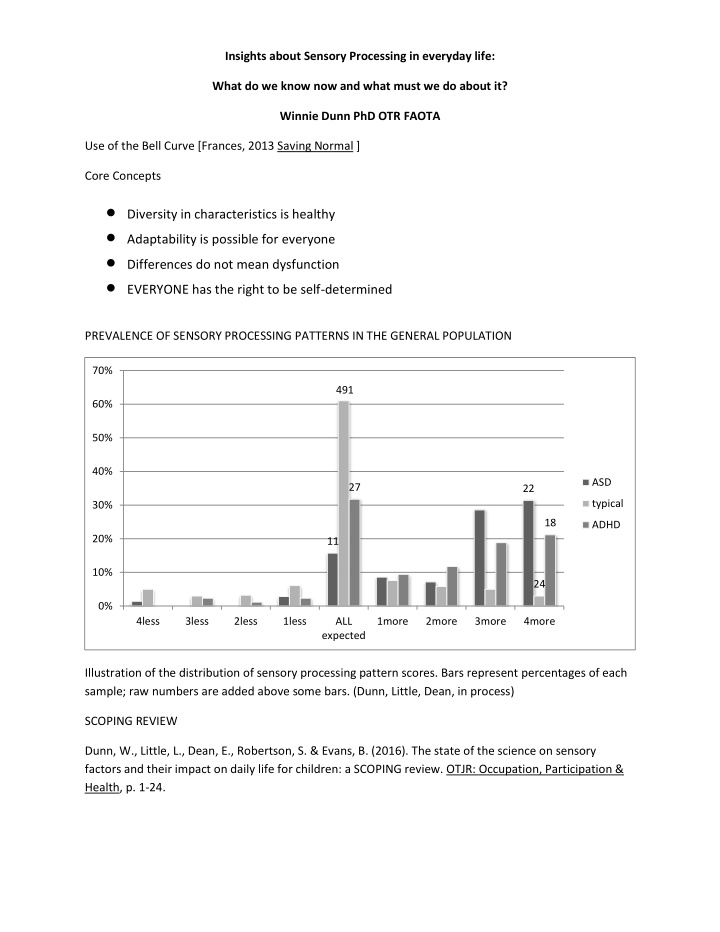



Insights about Sensory Processing in everyday life: What do we know now and what must we do about it? Winnie Dunn PhD OTR FAOTA Use of the Bell Curve [Frances, 2013 Saving Normal ] Core Concepts Diversity in characteristics is healthy Adaptability is possible for everyone Differences do not mean dysfunction EVERYONE has the right to be self-determined PREVALENCE OF SENSORY PROCESSING PATTERNS IN THE GENERAL POPULATION 70% 491 60% 50% 40% ASD 27 22 typical 30% 18 ADHD 20% 11 10% 24 0% 4less 3less 2less 1less ALL 1more 2more 3more 4more expected Illustration of the distribution of sensory processing pattern scores. Bars represent percentages of each sample; raw numbers are added above some bars. (Dunn, Little, Dean, in process) SCOPING REVIEW Dunn, W., Little, L., Dean, E., Robertson, S. & Evans, B. (2016). The state of the science on sensory factors and their impact on daily life for children: a SCOPING review. OTJR: Occupation, Participation & Health, p. 1-24.
SENSORY PROCESSING AND PARTICIPATION Related to school participation Auditory and visual processing was most often studied at school and does have a strong association with reading performance Children with dyslexia recognize the noise better than the speech sounds which suggests that there are some sensory filtering factors that we might consider and supporting them And for children with autism, modulation, auditory filtering and touch were associated with inattention at school In a study looking at sensory processing at school and home together researchers found Moderate correlations between home and school sensory patterns which suggests that in these two important context for children there are both universal truths and context specific truths when looking at sensory processing behaviors Related to daily life Children with sensitivity to taste and smell reject fruits & vegetables Other children’s profiles align with parents: touch sensitivity and unfamiliarity are not a factor Lower proprioception is related to sedentary play Children with ADHD and ASD have fewer play choices For FASD sensory processing differences associated with adaptive behavior For ASD/ADHD: low thresholds associated with less autonomy in self-care Low registration is associated with less involvement in self-care/daily living Lower thresholds are associated with lower competence Children with ADHD + differences in sensory processing have no differences in participation Children with ASD + differences in sensory processing have lower participation
Sensory processing informs incontinence interventions Children with FASD who have sensitivity sleep shorter amounts of time Children with FASD who have seeking sleep less Children with FASD who have avoiding wake up more Social Participation Children have the same levels of enjoyment with family and small groups of friends even when sensory processing is different Children in the general population who have sensitivities have differences in social interactions Coaching interventions increase parental competence; they then need less support Other Traits Adolescents with DCD use more visual cues, less proprioceptive cues Sensory stimulation has no effect on motor development of infants When parents have more information about movement, their children have better oral, self care, mobility There is a relationship between repetitive/ SIB & stereotypies and patterns of sensory processing Anxiety predicts under-responsivity ODD predicts over-responsivity Low threshold sensory patterns are associated with anxiety, shyness, low self-regulation, negative affect, challenging behaviors Registration sensory patterns are associated with withdrawal, negative mood, adaptability, persistence, and activity levels Children can separate perceptual information and therefore detect more sensory input than adults When children have a combination of low registration and touch sensitivity they have more challenges understanding emotions Interventions Effectiveness of sensory based approaches A few showed effectiveness Many show NOT effective Sensory based interventions have not been successful at consistently changing repetitive behavior patterns Equal outcomes to alternative interventions Different outcomes for comparison groups
Variable outcomes across the study Promising new ideas IMBEDDING IDEAS INTO ROUTINES IS EFFECTIVE Coaching with sensory processing info supports increases parental competence and children’s participation Parents want information for everyday life Tele-health was effective Summary statements re: interventions Dosage was quite variable [1 session to months] Developmental trajectory not considered Outcomes varied [motor to play to parental competence] Details about interventions not always available Alignment of interventions and outcomes variable What are clinically meaningful differences?
Recommend
More recommend